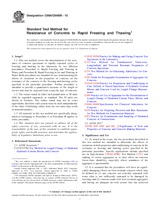Potřebujeme váš souhlas k využití jednotlivých dat, aby se vám mimo jiné mohly ukazovat informace týkající se vašich zájmů. Souhlas udělíte kliknutím na tlačítko „OK“.
ASTM C666/C666M-15
Standard Test Method for Resistance of Concrete to Rapid Freezing and Thawing (Withdrawn 2024)
Automaticky přeložený název:
Standardní zkušební metoda pro Resistanceââ,¬â € ° ofââ,¬â € ° Concreteââ,¬â € ° toââ,¬â € ° Rapidââ,¬â € ° Freezingââ,¬â € ° andââ,¬â € ° Rozmrazení
NORMA vydána dne 1.2.2015
Informace o normě:
Označení normy: ASTM C666/C666M-15
Poznámka: NEPLATNÁ
Datum vydání normy: 1.2.2015
Kód zboží: NS-585728
Počet stran: 7
Přibližná hmotnost: 21 g (0.05 liber)
Země: Americká technická norma
Kategorie: Technické normy ASTM
Kategorie - podobné normy:
Anotace textu normy ASTM C666/C666M-15 :
Keywords:
accelerated testing, concrete-weathering tests, conditioning, freezing and thawing, resistance-frost ,, ICS Number Code 91.100.30 (Concrete and concrete products)
Doplňující informace
| Significance and Use | ||||||||||||||||||||||
|
3.1?As noted in the scope, the two procedures described in this test method are intended to determine the effects of variations in both properties and conditioning of concrete in the resistance to freezing and thawing cycles specified in the particular procedure. Specific applications include specified use in Specification C494/C494M, Test Method C233, and ranking of coarse aggregates as to their effect on concrete freeze-thaw durability, especially where soundness of the aggregate is questionable. 3.2?It is assumed that the procedures will have no significantly damaging effects on frost-resistant concrete which may be defined as (3.3?If as a result of performance tests as described in this test method concrete is found to be relatively unaffected, it can be assumed that it was either not critically saturated, or was made with sound aggregates, a proper air-void system, and allowed to mature properly. 3.4?No relationship has been established between the resistance to cycles of freezing and thawing of specimens cut from hardened concrete and specimens prepared in the laboratory. 3.5?There is no specific guidance on choosing between Procedure A and Procedure B for a given application, except when contained in a specification. Specifications C233 and C494/C494M both stipulate Procedure A. In many instances the choice is based on the users determination of suitability to a specific application. Procedure A is generally considered to be the more aggressive of the two and to better reveal defective materials, although some consider the constant saturation of the test specimens to be unrealistic. Some users prefer Procedure B as being more representative of the saturation patterns in some field applications. The history of this standard and a more complete discussion of significance and use can be found in ASTM STP 169C and D[1, 2]. |
||||||||||||||||||||||
| 1. Scope | ||||||||||||||||||||||
|
1.1?This test method covers the determination of the resistance of concrete specimens to rapidly repeated cycles of freezing and thawing in the laboratory by two different procedures: Procedure A, Rapid Freezing and Thawing in Water, and Procedure B, Rapid Freezing in Air and Thawing in Water. Both procedures are intended for use in determining the effects of variations in the properties of concrete on the resistance of the concrete to the freezing-and-thawing cycles specified in the particular procedure. Neither procedure is intended to provide a quantitative measure of the length of service that may be expected from a specific type of concrete. 1.2?The values stated in either inch-pound units or SI units shall be regarded separately as standard. The SI units are shown in brackets. The values stated may not be exact equivalents; therefore each system must be used independently of the other. Combining values from the two units may result in nonconformance. 1.3?All material in this test method not specifically designated as belonging to Procedure A or Procedure B applies to either procedure. 1.4?This standard does not purport to address all of the safety concerns, if any, associated with its use. It is the responsibility of the user of this standard to establish appropriate safety and health practices and determine the applicability of regulatory limitations prior to use. |
||||||||||||||||||||||
| 2. Referenced Documents | ||||||||||||||||||||||
|
Doporučujeme:
Aktualizace zákonů
Chcete mít jistotu o platnosti užívaných předpisů?
Nabízíme Vám řešení, abyste mohli používat stále platné (aktuální) legislativní předpisy.
Chcete vědět více informací? Podívejte se na tuto stránku.




 Cookies
Cookies
